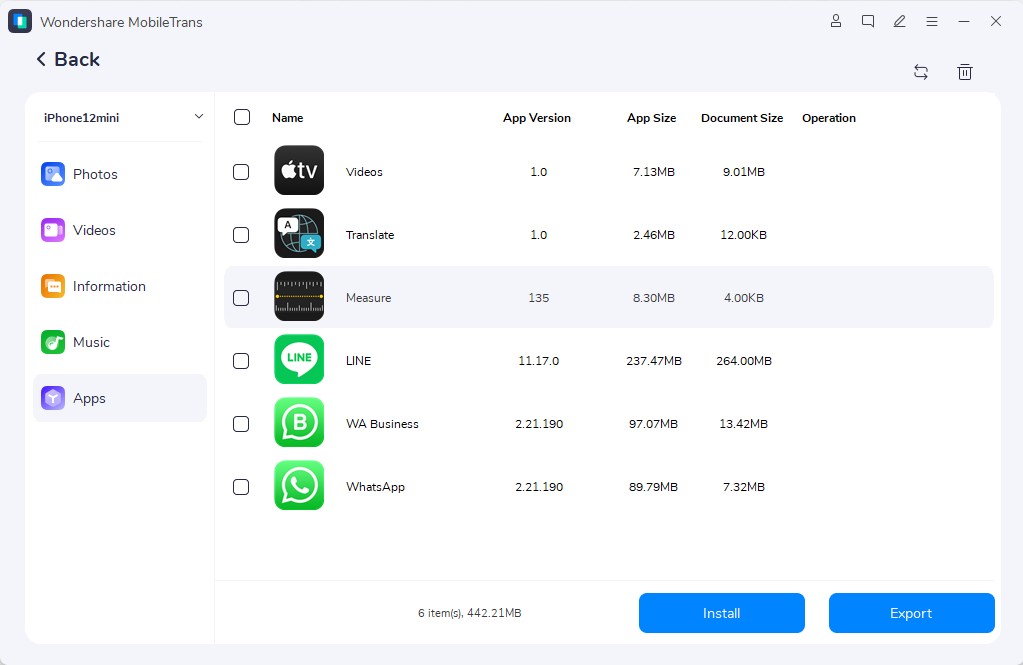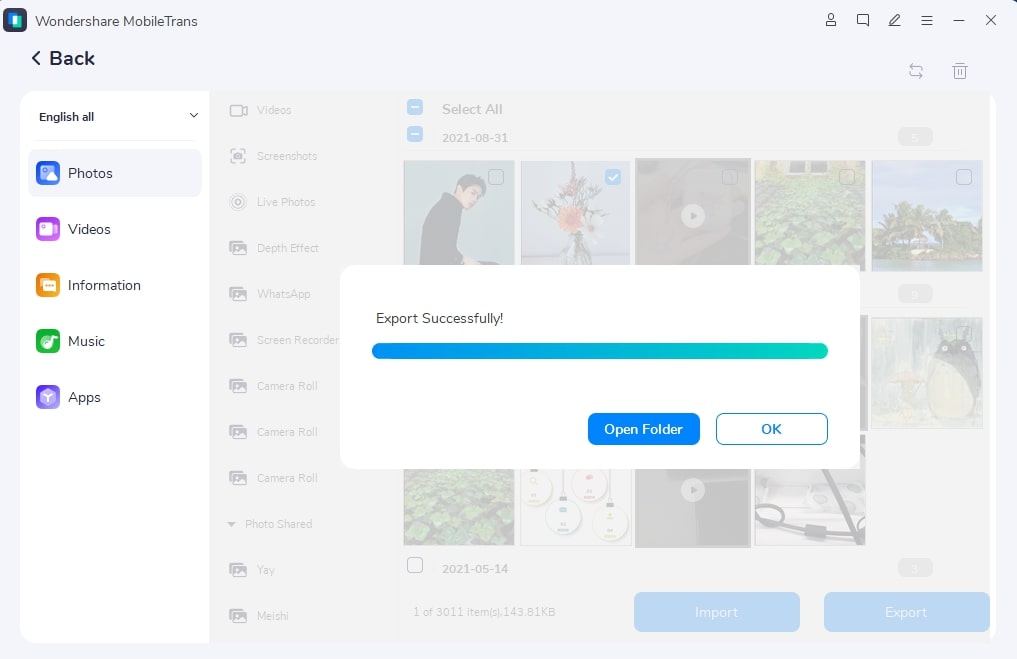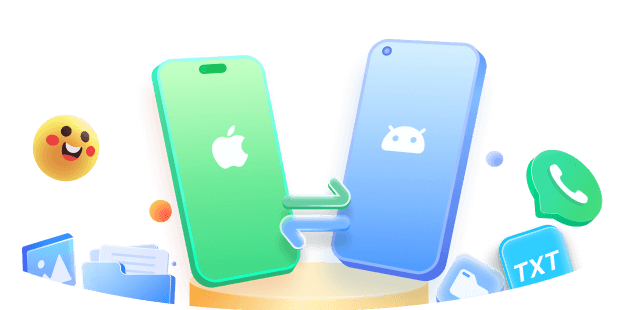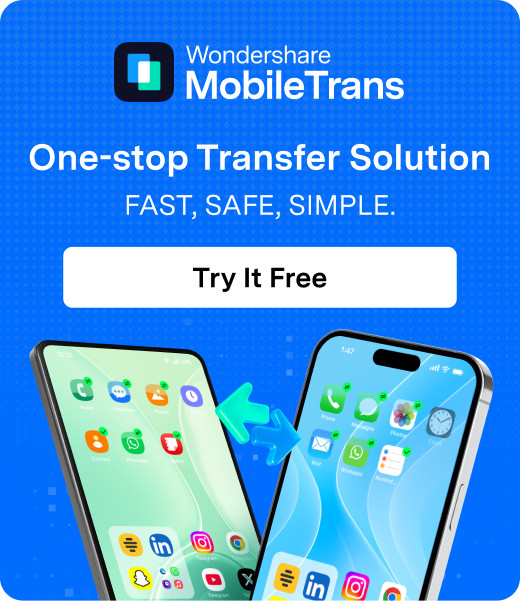Juggling multiple devices like phones and computers is a reality for most of us these days. But constantly switching between them and making sure our important information stays up-to-date across everything can be a real headache. That's where syncing your Android smartphone with your Mac comes in to save the day!
Syncing allows you to seamlessly share stuff like contacts, calendars, files, and notes between your Android and Mac automatically. No more manually transferring data or worrying about losing information when switching devices. With a few simple steps, you can keep all your digital life synchronized perfectly across both Android and Mac.
Say goodbye to mismatched calendars, outdated contact info, and lost documents. This guide will show you just how easy it is to sync Android with Mac for a truly streamlined and productive experience.
In this article
Part 1: Use MobileTrans to Sync Android to Mac
Wondershare MobileTrans - Phone Transfer makes it easy to share data between Android and Mac devices. It supports a wide range of data types, including photos, music, videos, apps, and more.
It does not access your data without your permission. Also, it doesn’t overwrite your data, so you can keep both old and new data on your Android and Mac.
MobileTrans supports Android, iOS, and MacOS systems and even transfers iCloud data to Android directly. So, yes, you can trust MobileTrans to do the job well, whether you are switching phones or just want to keep your stuff backed up.
Wondershare MobileTrans
Transfer Data Bewteen Android and Mac Easily
- • No data loss. No data leaks.
- • Support various data, including files, photos, videos, apps, contacts, etc.
- • Compatible with thousands of device types acorss Android and iOS.

 4.5/5 Excellent
4.5/5 ExcellentHere's how to use MobileTrans to sync Android to Mac:
Step 1: Get the MobileTrans tool and install it on your Mac. Use a USB cable to connect your Android phone to your Mac. Open MobileTrans and pick "Phone Transfer."

Step 2: Select “Export to Computer”. Decide and pick which stuff you want to move (like contacts, messages, calendars) from your Android phone to your Mac.

Step 3: Hit "Export" to begin moving everything.

MobileTrans offers a user-friendly interface and efficient syncing capabilities, making it a popular choice for those seeking a hassle-free sync experience to sync Android with Mac.
Part 2: Use Google Chrome Browser to Sync Android with Mac
If you primarily use Google services like Gmail, Google Contacts, and Google Calendar, you can sync your data between Android and Mac using the Google Chrome browser.
Here's how to enable syncing options on the Google Chrome browser:
Step 1: Open Google Chrome on your Mac and sign in to your Google account. Click on the three-dot icon on the top-right corner and select “Settings”.

Step 2: In the "Settings" window, switch to the “You and Google” tab from the left menu pane.

Step 3: Turn on the "Sync everything" option or select the specific data types you want to sync (e.g., bookmarks, passwords, browsing history, etc.).
Step 4: Repeat the same process on your Android device by opening the Google Chrome app and enabling syncing options.
By enabling syncing options on the Google Chrome browser, your data will be automatically synced across devices, ensuring that you have access to your information on both your Android phone and Mac.
Part 3: Android and Mac Sync Using Gmail
If you primarily use your Gmail account for managing contacts, you can sync your contacts between your Android device and Mac using the Gmail web interface. Here's how to sync your contacts to your Mac using Gmail:
Step 1: Open a web browser on your Mac and navigate to gmail.com. Sign in to your Gmail account.

Step 2: Click on the "Google Apps" icon (a grid of nine dots) in the top-right corner and select "Contacts."
Step 3: In the "Contacts" window, you should see all your synced contacts from your Android device.

Step 4: To add new contacts or make changes, simply edit the contact information, and the changes will be synced across devices.
This method allows you to keep your contacts updated and accessible on both your Android phone and Mac, ensuring that you always have the latest contact information at your fingertips.
Part 4: Sync Android with Mac via Google Drive
Google Drive is a cloud-based storage solution that allows you to sync files and folders across devices. By syncing your files and folders with Google Drive, you can access them from your Android phone and Mac, making it easier to work on projects and collaborate with others.
Here's how to sync files and folders using Google Drive:
Step 1: Download and install the Google Drive app on your Mac and Android device. Sign in to your Google account on both devices.

Step 2: On your Mac, open the Google Drive app and select the files or folders you want to sync. You can either choose the “Stream files” or “Mirror Files” option, based on your preference. Choose the files to transfer to Google Drive.

Step 3: On your Android device, open the Google Drive app, and you should see the synced files and folders.
By syncing your files and folders using Google Drive, you can easily access your documents, spreadsheets, presentations, and other files from both your Android phone and Mac, ensuring that you always have the latest versions at your fingertips.
Part 5: Tips to Seamlessly Sync Android to Mac
In addition to syncing your data, you may also need to share files between your Android device and Mac on occasion.
Here are some tips to ensure a seamless file-sharing experience:
- Use Cloud Storage Services: Cloud storage services like Google Drive, Dropbox, or iCloud can facilitate easy file sharing between your Android phone and Mac. Simply upload the files to the cloud service from one device and access them on the other.
- Utilize Email or Messaging Apps: For quick file transfers, you can attach the files to an email or send them via messaging apps like WhatsApp or Telegram. This method is particularly useful for sharing smaller files.
- Employ Wireless File Transfer: Tools like Zapya or SHAREit allow you to wirelessly transfer files between your Android device and Mac over a local network or via a direct Wi-Fi connection, eliminating the need for cables or cloud storage.
- Use a USB Cable: For larger file transfers or when dealing with multiple files, you can connect your Android device to your Mac using a USB cable. This method allows you to access your Android device's file system directly from your Mac and transfer files back and forth.
- Explore Third-Party Apps: There are various third-party apps available that facilitate file sharing between Android and Mac devices. Apps like Wondershare MobileTrans, Pushbullet, or Portal can provide additional features and customization options to enhance your file-sharing experience.
By employing these tips, you can ensure a smooth and efficient file-sharing experience between your Android device and Mac, enhancing your productivity and simplifying your workflow.
Conclusion
In today's increasingly connected world, to sync Android with Mac has become more than just a convenience; it's a necessity for maintaining productivity, organization, and seamless access to your data across multiple platforms.
By following the methods outlined in this guide, you can unlock the full potential of integrating your Android smartphone with your Mac computer.
Whether you choose to use the powerful MobileTrans tool, leverage the syncing capabilities of Google services, or explore a combination of these methods, keeping your data synchronized will streamline your daily tasks. It will help you enhance collaboration, and provide peace of mind knowing that your valuable information is securely backed up and readily available.

 4.5/5 Excellent
4.5/5 ExcellentFAQ
-
Is it necessary to have a Google account to sync my Android device with my Mac?
While having a Google account can simplify the syncing process, especially when using Google services like Chrome, Gmail, and Google Drive, it is not an absolute requirement. Tools like MobileTrans allow you to sync your data without relying on a Google account. -
Can I sync my Android device with multiple Macs?
Yes, most syncing methods discussed in this guide support syncing your Android device with multiple Mac computers. This can be particularly useful if you use multiple Macs for different purposes or share devices with family members. -
Will syncing my data across devices consume a significant amount of storage space?
The storage requirements for syncing data depend on the type and volume of data you're syncing. For contacts, calendars, and notes, the storage requirements are generally minimal. However, syncing large media files like photos and videos can consume more storage space on your devices and cloud services.






